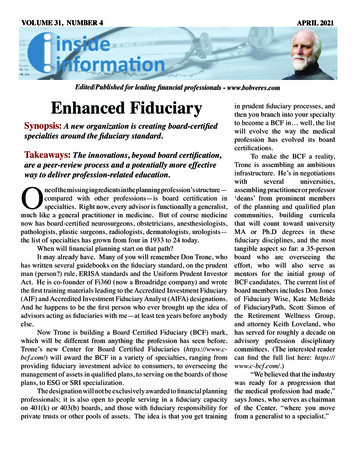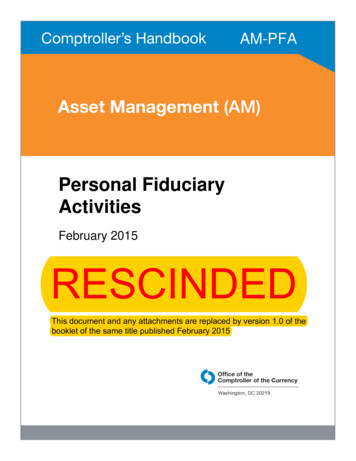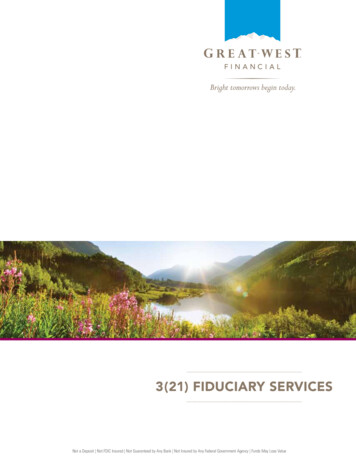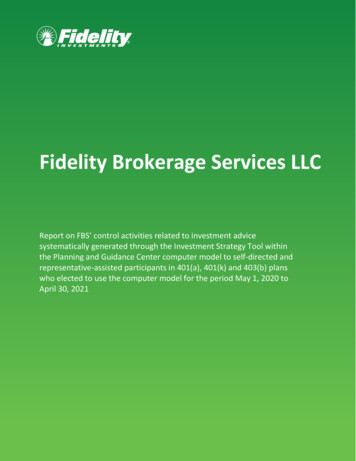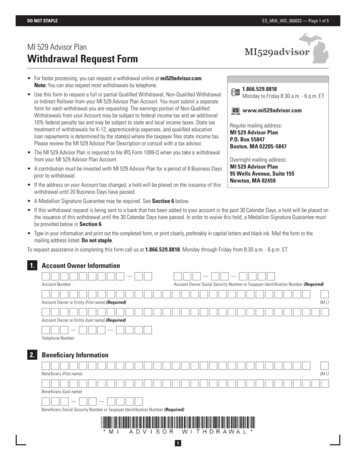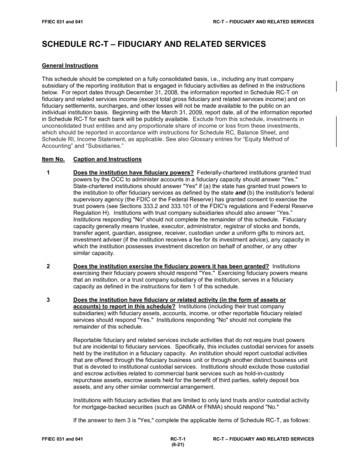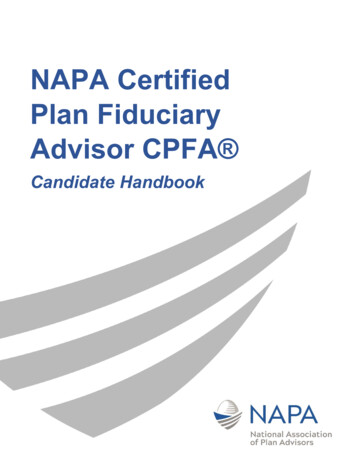
Transcription
NAPA CertifiedPlan FiduciaryAdvisor CPFA Candidate Handbook
Candidate HandbookTable of ContentsIntroduction .2Section 1: NAPA CPFA Credential Requirements .3Section 2: Preparing for the NAPA CPFA Certification Exam .4Section 3: Exam Administration .5Section 4: Applying for NAPA CPFA Credentialed Membership .8Section 5: NAPA CPFA Continuing Education Requirements .10Section 6: NAPA CPFA Certification Exam Content Outline .13Section 7: ARA Code of Professional Conduct .16 2022 American Retirement Association1
Candidate HandbookIntroductionAbout the NAPA CPFA CredentialThe Certified Plan Fiduciary Advisor (CPFA ) credential – developed by some of the nation'sleading advisors and retirement plan experts – demonstrates your knowledge, expertise, andcommitment to working with retirement plans. Plan advisors who earn their CPFA demonstratethe expertise required to act as a plan fiduciary or help plan fiduciaries manage their roles andresponsibilities.About the National Association of Plan AdvisorsThe National Association of Plan Advisors (NAPA),an affiliate organization of the AmericanRetirement Association, was created by and forretirement plan advisors. Membership is alsoopen to other retirement industry professionalswho support the interests of plan advisors.NAPA Membership offers fourvaluable benefits: advocacy,education, business intelligence,and networking – all designed tokeep plan advisors in the forefrontof the industry and help themsucceed.While the financial services industry is wellrepresented in Washington by several tradeassociations that weigh in on issues affectingadvisors, NAPA is the only advocacy groupexclusively focused on the issues that matter toretirement plan advisors. This exclusive focus is what sets NAPA apart.About the American Retirement Association (ARA)The American Retirement Association (ARA) is a non-profit organization that aims to educateretirement plan professionals and create a framework of policy that gives every workingAmerican the ability to have a comfortable retirement.As part of that mission, for more than half a century, the ARA has developed and distributededucation programs, information resources, and professional credentials that have become thegold standard for retirement plan professionals in every field of endeavor.More than 33,000 members strong, today the American Retirement Association is comprised offive premier retirement industry associations: the American Society of Pension Professionals &Actuaries (ASPPA), the American Society of Enrolled Actuaries (ASEA), the NationalAssociation of Plan Advisors (NAPA), the National Tax-deferred Savings Association (NTSA),and Plan Sponsor Council of America (PSCA). 2022 American Retirement Association2
Candidate HandbookSection 1: NAPA CPFA CredentialRequirementsSummaryNAPA has developed requirements for eligibility to ensure that the application process is fairand impartial for all applicants. Each eligibility requirement has been established to ensure thatindividuals certified by NAPA have an acceptable level of knowledge and proficiency necessaryto administer retirement plans.To obtain the CPFA credential, individuals must: Successfully complete the NAPA CPFA examAgree to abide by the ARA Code of Professional ConductApply for the credentialExam RequirementThe CPFA exam is a 70-question multiple choice exam that assesses a candidate’sknowledge of key retirement plan concepts commensurate with professional retirement planadvisor standards. Candidates must earn a passing score of 70% or greater on the CPFA exam to qualify for NAPA CPFA credentialed membership.Experience and Education RequirementNo specific experience level is required, but if you are new to retirement plan sales, you mightfind it helpful to begin with NAPA’s 401(k) Practice Builder.Application RequirementCandidates must apply for NAPA credentialed membership and agree to abide by the ARACode of Conduct and NAPA continuing education policy.Qualified Plan Financial Consultant (QPFC) Credential AlternativeCPFA candidates may elect to use the Qualified Plan Financial Consultant (QPFC) credentialif their broker/dealer requires use of QPFC rather than CPFA credential on advertisingmaterial. The coursework, exam and application requirements are the same for both the QPFCand the CPFA credential.CPFA and QPFA credential holders may switch credential titles as required by theirbroker/dealer at no cost by submitting a request to accountsreceivable@usaretirement.org.Candidates are encouraged to speak to their compliance department prior to selecting theCPFA or QPFC designation on the NAPA credentialed membership application. 2022 American Retirement Association3
Candidate HandbookSection 2: Preparing for the NAPA CPFA Certification ExamSummaryThe number of hours of study needed to prepare for NAPA examinations varies depending onthe length and breadth of a candidate’s experience in the field. Many successful candidatesbegin studying several months before an examination date to allow sufficient time to cover allthe material to the proper extent.NAPA has available study materials to help individuals prepare for the CPFA certificationexam. The CPFA Online Course is the preferred study material for the examination and canbe purchased separately.The CPFA online course is divided into four modules covering all the examination content:1.2.3.4.Fiduciary Management under ERISAERISA Plan Management 1ERISA Plan Investment ManagementERISA Plan Management 2The modules listed above contain: All content covered in the examination, presented using case studiesInteractive practice activities based on real life situationsMultiple-choice sample questions that mimic the questions found on the examinationAdditional resources for continuous learning 2022 American Retirement Association4
Candidate HandbookSection 3: Exam AdministrationNAPA CPFA Exam FormatThe CPFA exam is a 70-question multiple-choice exam. Candidates have 2 ½ hours tocomplete the exam.Exam FeesThe exam fee is 390.Exam DeliveryThe CPFA exam is delivered using a proctored online examination system. Candidates needaccess to a laptop or desktop computer with webcam and microphone to participate in theexam. Candidates are provided system requirement documentation and system verificationtools upon enrollment in the exam.Candidates are permitted to use the browser-based calculator or the Windows on-screencalculator to perform calculations. Candidates may use the notes field to record results in multistep calculations. Candidates may not use cell phones, handheld calculators, or other softwarebased calculators during the exam. Using paper to take notes or perform calculations during theexam is prohibited.Exam EnrollmentNAPA will enroll candidates into the NAPA online exam administration system within three (3)business days of the candidate’s exam purchase or exam enrollment request. Candidates willbe provided written instructions on how to access the online exam system, perform systemfunctionality tests, and take a sample exam session prior to taking the exam.Exam WindowThe exam window is three complete calendar months following the date of exam enrollment.Candidates will receive written confirmation of the exam window and exam expiry date.Exam ScoringThe final score will be reported to candidate after provisional score is reviewed and confirmedby NAPA staff.Time LimitAll credential exams are timed and must be completed within the allotted time. For CPFA, thetime limit for the exam is 2½ hours. Exams cannot be paused and resumed after starting. Anyexam questions left unanswered at the end of the allotted time will be counted as incorrect.Exam ResultsCandidates will receive an email from the NAPA exam system after exam results are validated.Candidates will be directed to access the NAPA exam system to view their exam score, reviewtheir score report, and download a certificate of completion if they have passed. For securityreasons, results will not be provided over the phone or sent by fax. 2022 American Retirement Association5
Candidate HandbookScore ReportsCandidates may request a score report upon completion and approval of the NAPA CPFA exam. Score reports will indicate how an individual performed in each topic area.LanguageThe CPFA credential exam is offered in English.Test Administration ModificationSpecial accommodations to test administration shall be provided to candidates with a disability(as defined by Title III of the Americans with Disabilities Act) who submit with their certificationapplication a written explanation of their needs and appropriate documentation. Requests mustbe submitted no less than six weeks prior to test date to allow sufficient time for arrangementsto be made on behalf of the test candidate. Application forms for these accommodations mustbe submitted in writing to rpa@usaretirement.org.Statement of Non-DiscriminationNAPA endorses the principles of equal opportunity. Eligibility criteria for examination andcredentialing as a CPFA are applied equally to all individuals regardless of age, race, religion,gender, national origin, veteran status, or disability.ConfidentialityNAPA recognizes candidates’ rights to control personal information. NAPA’s policy is designedto safeguard this information from unauthorized disclosure. Candidates can change preferencesto be contacted by updating personal preferences in their profiles. To protect the rights tocontrol score distribution, exam scores are released only to the candidate and authorized NAPAor ARA staff.NAPA does not release individual exam scores, except for use in research studies that preservecandidates’ anonymity. Candidates’ scores will always remain confidential unless authorizedwith the written consent of a candidate. Official statistics regarding the CPFA credentialingexam, including all question performance data, individual data, and demographic data, will beconsidered confidential; however, NAPA reserves the right to publish aggregated, nonidentifying information based on such data.Exam IrregularitiesAny problems, suspected instances of cheating, alleged inappropriate examinationadministration, environmental testing conditions severe enough to cause disruption of theprocess or any other irregularities related to test administration should be brought to theattention of NAPA at customercare@napa-net.org. All such matters will be reported,investigated and subject to further action based on policies and procedures adopted by NAPA.Cheating or other violations of the ARA Code of Conduct, or matters that may constitutegrounds for disciplinary action, will be handled under the disciplinary procedures adopted byARA, but other issues in examination irregularities are not subject to appeal. 2022 American Retirement Association6
Candidate HandbookViolation of Code of ConductIf it is determined that a candidate has violated the ARA Code of Conduct, the candidate may bebarred from taking the exam for a timeframe determined by ARA.NAPA Credential Candidate Inquiry PolicyCandidates may submit written inquiries about NAPA study materials and credentialing exams.Inquiries regarding NAPA credentialing exams must be submitted by the exam candidate torpa@usaretirement.org within 30 days of the exam administration date.NAPA will not review or respond to inquiries submitted on the candidate’s behalf.Correspondence will be conducted in accordance with NAPA’s privacy policy contained in thishandbook.Exam Refund & Transfer PolicyFees for examinations are not refundable. The right to sit for a NAPA examination belongsexclusively to the person named on the exam registration request. Candidates named on theexam registration request may transfer the right to another candidate. The transfer request mustbe submitted in writing to accountsreceivable@usaretirement.org not less than 15 days prior tothe exam window expiry date. 2022 American Retirement Association7
Candidate HandbookSection 4: Applying for NAPA CPFA Credentialed MembershipCredentialed Membership ApplicationCandidates who earn a passing score on the CPFA exam may apply for NAPA CPFAcredentialed membership by completing the NAPA Credentialed Membership application.Candidates must agree to abide by the ARA Code of Conduct, comply with the NAPAcontinuing education policy, and pay NAPA credentialed membership dues and/or credentialmaintenance fees.Credential Maintenance FeeThere is an annual credential maintenance fee for retirement plan advisors affiliated with NAPAfirm partners. Credential maintenance fees are due December 31 of each calendar year.First-year credential maintenance fees will not be assessed to CPFA candidates awarded theCPFA credential from December 1 to December 31.The current list of NAPA firm partners may be found at https://www.napa-net.org/aboutus/partner-corner. Credentials are suspended if credential maintenance fees are not paid byFebruary 28.NAPA Membership DuesCPFA candidates who are not affiliated with a NAPA firm partner or who are credentialedmembers of one or more ARA sister organizations are required to maintain NAPA credentialmembership to hold the CPFA designation. Membership applications and membership duesrates may be found at https://www.napa-net.org/member/join. A due date for member dues isn’tincluded here but is for the maintenance fee.Credential Mark Usage Policies and ProceduresAn individual who has been granted the NAPA CPFA membership may list the credential onstationery, websites, business cards and other promotional materials as: First name, Last name, NAPA CPFA First name, Last name, Certified Plan Fiduciary Advisor First name, Last name, CPFA Note: Only include the symbol with the first instance of the acronym, in body copy; insubsequent instances, the acronym by itself is appropriate.Should the credential be suspended or withdrawn for any reason, the individual mustimmediately cease the use of the title NAPA Certified Plan Fiduciary Advisor and acronymdesignation on stationery, websites, business cards, and all promotional materials. 2022 American Retirement Association8
Candidate HandbookNAPA CPFA Credential CheckNAPA maintains a public website for verification of CPFA credential status. The public canverify that a retirement plan advisor is entitled to use the NAPA CPFA designation athttps://napacredentialcheck.org/. 2022 American Retirement Association9
Candidate HandbookSection 5: NAPA CPFA ContinuingEducation RequirementsAs a professional society, NAPA recognizes the importance of the continuing educationaldevelopment of its members. NAPA has a mandatory program of Continuing Education (CE)that affects all NAPA credentialed members who hold a NAPA CPFA credential. CErequirements apply to all credentialed members, regardless of when the credential(s) wereawarded.Annual Continuing Education RequirementCPFA designation holders must complete ten (10) hours of Continuing Education (“CE”) eachcalendar year following the calendar year the CPFA designation is earned. CE hours must meetthe Continuing Education Content Standards outline below.Each calendar year a minimum of four (4) hours of the annual ten (10) hour CE requirementmust cover retirement plan relevant topics (“Relevant Topics”) identified in this continuingeducation policy statement. In addition, a minimum of one (1) hour of CE credit earned annuallymust address professional ethics and the ARA’s Code of Professional Conduct.Continuing Education Content StandardsCE must meet the following standards qualify for continuing education credit: Content must be developed by person(s) qualified in the subject matter.CE hours reported shall match the actual time on task rounded down to the nearest five(5) minute increment.o One (1.0) hour of CE is equivalent to 50 minutes of instruction or study time ontasko After the first 50 minutes, CE hours may be accrued in 5-minute incrementswhere 5 minutes is equal to one tenth (0.1) of a CE credit.o CE will not be accepted for any event less than 45 minutes time on task. This isequivalent to a nine-tenths (0.9) CE threshold.Relevant TopicsRelevant Topics that will satisfy the four (4) hour retirement plan education requirementincludes, but is not limited to, the following Relevant Topics: Retirement Plan Legislative and Regulatory UpdatesNonqualified PlansQualified Plan Features and AdministrationFiduciary ResponsibilitiesRetirement Plan Employer and Participant CommunicationsRetirement Plan ProductsRetirement Plan Sales Process 2022 American Retirement Association10
Candidate HandbookThird Party CE Designation holders are responsible for reporting third party CE activity using the NAPACE reporting system.Records of completion of third-party CE must be maintained by the designation holderfor a minimum of two (2) calendar years following the calendar year for which the CEcredit is reported.Third party CE is subject to audit.NAPA Provided CE NAPA will record CE credit for participation in NAPA CE events.NAPA will ensure that that NAPA provided CE meets both continuing education contentstandards and addresses retirement plan related Relevant Topics.Compliance and AuditThe audit of third-party CE is conducted for the benefit of all NAPA members and CPFA credential holders. The CE audit process demonstrates NAPA’s ongoing commitment toprofessionalism and the integrity of the CPFA program. The CE audit process helps ensurecompliance with the CE policy, but more importantly will help NAPA identify opportunities tocontinuously improve the CFPA CE program.The Audit ProcessNAPA will conduct an annual audit of reported third party CE. The audit will encompass arandomly selected representative sample of designation holders who reported third party CE theprior calendar year.Designation holders who are randomly selected for the CE audit will be asked to providesuitable documentation to substantiate that the reported third-party CE meets the ContinuingEducation Content Standards. In general, the documentation must demonstrate that: The content was developed by a subject matter expert with expertise pertinent to thesubject matterTime on task for the CE credit awardedSuccessful completion or participationThe designation holder subject to audit will also be asked to provide a description of the CEsession for any third-party CE reported to satisfy the ethics or retirement plan related RelevantTopic requirement.Suspension of DesignationThe CPFA designation may be suspended for the following reasons Failure to comply with the NAPA Continuing Education PolicyFailure to renew NAPA membership or NAPA credential maintenance fee as applicableViolation of the NAPA Code of ConductFailure to comply with the NAPA Continuing Education PolicyDesignation holders will have until March 1 of each calendar year to report CE for the priorcalendar year CE cycle. NAPA provided CE earned prior to March 1st of each calendar year 2022 American Retirement Association11
Candidate Handbookmay be applied to the CE reporting cycle for the prior calendar year. In no case will CE berecorded for more than one CE reporting cycle.If the failure to comply with the NAPA Continuing Education Policy results from the audit of thirdparty CE, the designation holder will have 60 days from the date of notification to correct thedeficiency.Failure to Renew NAPA Membership or NAPA Credential Maintenance FeeDesignation holders are expected to remain NAPA members in good standing and make timelypayment of any designation maintenance fee that may be required by NAPA. Failure to pay anyrequired fees by March 1 of each calendar year will result in suspension of the designation.Violation of the ARA Code of ConductSuspension and/or revocation of designations due to actual or reported violation of the ARACode of Conduct is addressed in the ARA Code of Conduct Disciplinary Procedures.Revocation of DesignationThe designation will be revoked for designation holders who do not correct the deficiency ordeficiencies that initiated suspension of the designation.ReinstatementReinstatement may be granted if the following conditions are met prior to the end of thecalendar year following the calendar year a designation is suspended or revoked: The reinstatement application and new membership application is submitted,Required fees including membership, credential maintenance and reinstatement feesare paid in full, andDocumentation is provided demonstrating completion of required 10 CE (including oneEthics) in the 12 months preceding submission of the application 2022 American Retirement Association12
Candidate HandbookSection 6: NAPA CPFA Certification ExamContent OutlineFiduciary Roles and Responsibilities (9-11%)1.2.3.4.5.6.7.8.Explain ERISA exclusive purpose and ERISA prudence rule.Identify named fiduciaries.Identify actions that might establish a fiduciary relationship.Explain roles and responsibilities of named fiduciaries.Identify actions covered by the Best Interest Contract Exemption.Differentiate investment advice and investment education.Describe the “best interest contract exemption” under the DOL fiduciary regulation.Differentiate between 3(16), 3(21) and 3(38) fiduciaries.Non-Fiduciary Service Providers (5-7%)1. Identify ministerial functions performed by non-fiduciary service providers.Plan Governance and Fiduciary Documentation (5-7%)1. Identify required and additional documentation for maintaining plan records accordingto fiduciary best practice.2. Explain service provider role in assisting with prudent process documentation.3. Identify when plan documents should be updated.Fiduciary Oversight (9-11%)1. Identify parties-in-interest to the plan.2. Identify Prohibited Transactions and possible fiduciary breach events.3. Identify possible consequences of Prohibited Transactions and fiduciary breachevents.4. Explain the DOL role in overseeing plans.5. Explain how common problems can be corrected using DOL and IRS correctionprograms.Analyze situations for possible Ethics issues under conflicts of interest.Explain best practice for determining reasonableness of fees.Classify expenses as payable and not payable by the plan assets.Identify main consequences of not documenting prudent process for reviewing feesand services.10. Compare and contrast a Fidelity bond and fiduciary insurance.6.7.8.9. 2022 American Retirement Association13
Candidate HandbookPlan Goals and Objectives (7-9%)1.2.3.4.List considerations when formulating plan goals and objectives.Identify Plan Sponsor's business structure and related entities.Explain impact of family and related company ownership on plan design.Describe impact of cash flow and budget on plan design.Plan Types and Provisions (5-7%)Compare and contrast IRA-based plans to 401(k) plans.Explain hybrid plan combinations.Explain plan features.Summarize how plan features support plan goals and objectives.Explain which plan features are optional based on the plan design.Describe roles and responsibilities of the parties involved in creating plan documentsbased on plan design.7. Explain the different components of an adoption agreement.8. Identify required and optional amendments.1.2.3.4.5.6.Participant Outcomes (8-10%)1. Explain importance of successful participant outcomes to Plan Sponsor and2.3.4.5.participants.List considerations for Plan Sponsor to help create successful participant outcomes.Compare and contrast education approach and behavioral finance techniques.Explain re-enrollment process.Evaluate participant outcome by using gap analysis.Service Provider Selection (3-5%)Explain the roles of service providers.Identify factors used to assist in service provider selection.Describe fiduciary prudent process for selecting service providers.Explain different types of service providers, including bundled and unbundled servicemodels.5. Describe the role of Plan Sponsors regarding required participant disclosures.1.2.3.4.Educating Fiduciaries on Plan Investments (7-9%)1.2.3.4.5.6.7.8.Explain risk/return, asset classes and diversification of investments.Explain differences and similarities between investment options.Compare to/through target date funds.Explain Qualified Default Investment Alternative (QDIA) rules.Compare asset allocation fund models, including impact on participant outcomes.Compare active and passive management.Explain the impact of revenue sharing on fiduciary prudent process.Summarize the process of prudent investment selection. 2022 American Retirement Association14
Candidate HandbookInvestment Policy Statement (7-9%)1. Explain fiduciary prudent process to create a broad-based IPS.2. Identify basic criteria and procedures to follow when selecting and replacing investmentoptions.3. Identify parties responsible for maintaining the IPS.4. Describe fiduciary prudent process to change IPS according to best practices.Plan Investment Oversight (9-11%)1. Identify components of investment reviews.2. Recommend the frequency for performing investment reviews and/or plan committeemeetings.3. Describe the importance of investment performance evaluation for a fiduciary prudentprocess.4. Determine when investment replacements are appropriate.5. Identify best practice documentation needed for documenting prudent process whenmonitoring plan investments.Liaison Services (2-4%)1. Explain daily activities required by plan sponsor staff while interacting with serviceproviders.2. Identify most important actions to prevent most common errors.Retirement Plan Committee and Fiduciary Training (8-10%)1.2.3.4.5.Identify the role of adviser related to the Retirement Plan Committee.Identify attributes of an effective Retirement Plan Committee.Explain the importance of meetings for fiduciary due diligence.Identify best practices for fiduciary training.Describe the process for appointing and replacing fiduciaries.Conversions (2-4%)1. Identify conversion documentation as a plan management best practice.2. Identify conversion documents that are part of a plan management prudent process 2022 American Retirement Association15
Candidate HandbookSection 7: ARA Code of ProfessionalConductThe purpose of this Code of Professional Conduct (“Code”) is to identify the professional andethical standards with which a member must comply to fulfill the Member’s responsibility to theAmerican Retirement Association and its affiliate organizations, other Members, and thepublic. Members are required to adhere to the high standards of conduct, practice, andqualification set forth in this Code.1. Definitions Actuary: an individual who is a Member of the American Retirement Association andholds an MSPA or FSPA from the ASPPA College of Pension Actuaries or an actuarialcredential from another organization that is a member of the International ActuarialAssociation (IAA) or is an enrolled actuary in good standing with the Joint Board for theEnrollment of Actuaries.Advertising: all communications by whatever medium, including oral communications,which may directly or indirectly influence any person or organization to decide whetherthere is a need for Professional Services or to select a specific person or firm to performsuch services.Confidential Information: information not in the public domain of which the Memberbecomes aware during the course of rendering Professional Services to a Principal. Itmay include information of a proprietary nature, information which is legally restrictedfrom circulation, or information which the Member has reason to believe that thePrincipal would not wish to be divulged.Credential: a membership designation (e.g., Certified Pension Consultant; Member,Society of Pension Actuaries; or Associated Professional Member) conferred byAmerican Retirement Association.Law: statutes, regulations, judicial decisions, and other statements having legally bindingauthority.Member: An individual who is a Member of American Retirement Association or anyaffiliate organization of American Retirement Association.Principal: any present or prospective client of a Member or the employer of a Memberwhere the Member provides retirement plan services for their employer’s plan.Professional Communication: a written, electronic or oral communication issued by aMember with respect to Professional Services.Professional Services: services provided to a Principal by a Member, including therendering of advice, recommendations, findings, or opinions related to a retirement orother employee benefit plan.Titles: leadership positions, volunteer experience, awards and other honors conferred byAmerican Retirement Association. 2022 American Retirement Association16
Candidate Handbook2. AdvertisingMember shall not engage in any Advertising with respect to Professional Services that theMember knows or is reasonably expected to know are false.3. CommunicationsA Member who issues a Professional Communication shall take appropriate steps to ensurethat the Professional Communication is appropriate to the circumstances and its intendedaudience.4. ComplianceA Member shall be knowledgeable about this Code, keep current with Code revisions and abideby its provisions. Laws may impose binding obligations on a Member. This Code is notintended to supplant, contradict or supersede Law (e.g., Circular 230) or other Codes ofConduct that establish professional standards for Members in the
NAPA will enroll candidates into the NAPA online exam administration system within three (3) business days of the candidate's exam purchase or exam enrollment request. Candidates will be provided written instructions on how to access the online exam system, perform system

